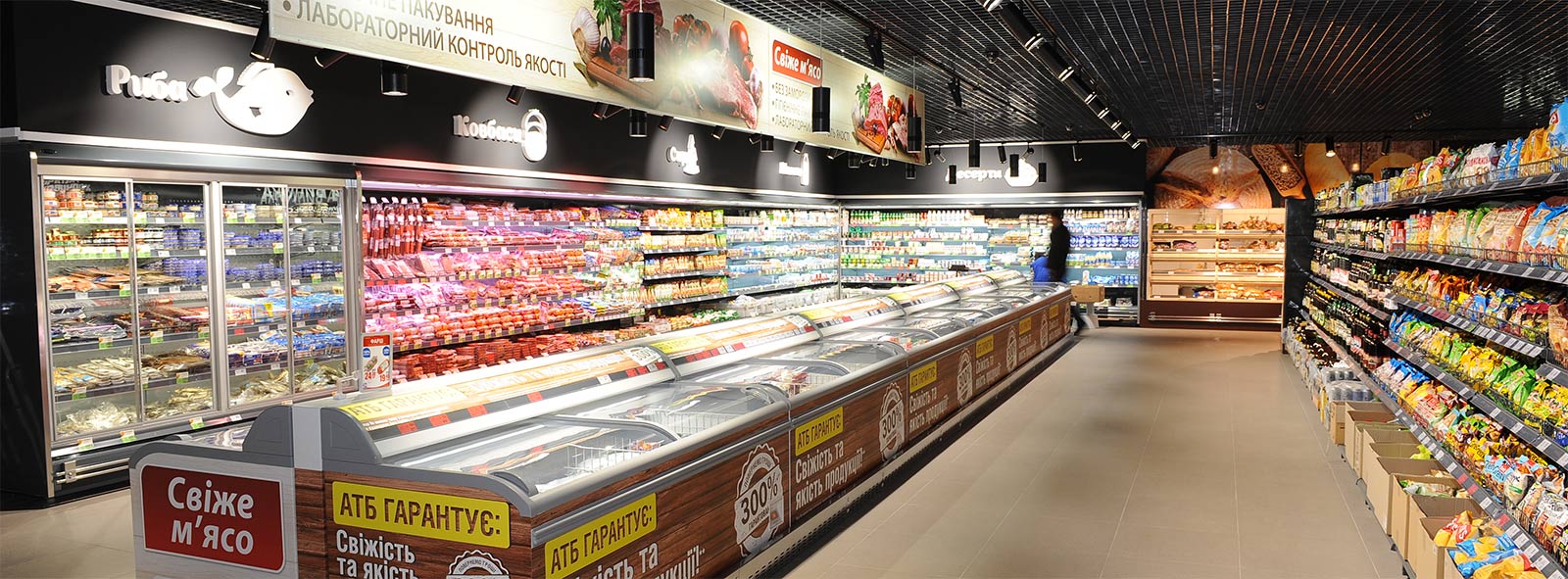
Monitoring system for a supermarket
Project description
One of our customers, a system integrator in the field of refrigeration systems, turned to us with the task of building supervisory control (monitoring) system a new facility – a supermarket of the ATB trade network. The introduction of monitoring systems at these sites was carried out as part of a program to improve the energy efficiency of stores.
The stages of this program were:
- Technical audit of all engineering systems
- Determining ways to improve the performance of large energy consumers, such as cold storage systems
- Implementation of technical (use of recuperation, optimization of compressor operation, etc.) and organizational measures (control of resource costs and maintenance of established consumption limits) to optimize energy consumption
- Providing objective operational reports to the end customer
Ultimately, the finished monitoring system was to be transferred to the operating service of the final customer as a ready-made tool.
The customer already had experience working with integration controllers of refrigeration equipment manufacturers, however these devices are specialized and work oriented only with the same compatible automation devices. Integration of other systems would also have been possible, but then it had involved significant difficulties in integrating third-party equipment into the network of the integration controller – this requires additional gateways, PLCs for implementing automatic control elements, it is impossible to ‘seamlessly’ configure the project from one location, etc.
In addition, the integration controllers used earlier allowed to solve the task of monitoring only a particular object separately, whereas for the efficient operation of the operatros and the customer service, a single monitoring system of the entire network of facilities is required.
After considering the functionality of WebHMI, the customer decided to do monitroing based on it – this would allow managing not only the refrigeration, but also the entire engineering infrastructure of the facility from one place – lighting, heating, ventilation and air conditioning, refrigeration equipment and showcases, zones of consumption. And to create a supervisory control center for the management of dozens of stores can thanks to the developer provided a cloud data service
Level2.
Obligatory conditions alse were the possibility of remote control over the Internet, providing differernt access rights with the recording of operator actions, SMS and Viber-informing, the execution of various scenarios and the management of processes on a schedule.
Equipment list
Lighting:
- several groups of lighting (warehouse, shopping hall, outdoor advertising), dimming.
Ventilation and air conditioning:
- 4 ventilation systems
- 5 air conditionners
Heating:
- warm floor
Electricity:
- 10 electric power meters NIK-2303, LE-03M (RS-485 and pulse outputs), through which the monitoring of all all major groups of consumers is made and technical accounting as well.
Refrigeration systems and freezing cameras:
- 2 frequency inverters for one- and two-stage compressors
- 3 low temperature cameras with control of local refrigeration controllers
Shopwindows:
- shopwindows and boothes with products having their own refrigerating controllers – 13 pcs.
Description of the solution
Due to the presence in WebHMI of all the functionality necessary for the task, the monitoring system for the store was completely made just one such an integration controller. The project involves more than 2000 registers from several dozen automation devices.
The system has a web-interface and provides the ability to manage simultaneously several operators (the service of the system installer, the store’s own service-service,the manager) with different access rights, from various devices (including smartphones and tablets) both from the local network, Wi-Fi, and remotely via the Internet.
WebHMI, the manager of engineering systems, is connected to the cloud service Level 2,, the top level for systems built on WebHMI that provides easy access to it via the Internet without the presence of fixed IP-addresses (valuable for connecting through 3G, and large corporate networks), as well as further development of the system with the connection of other stores of this network.
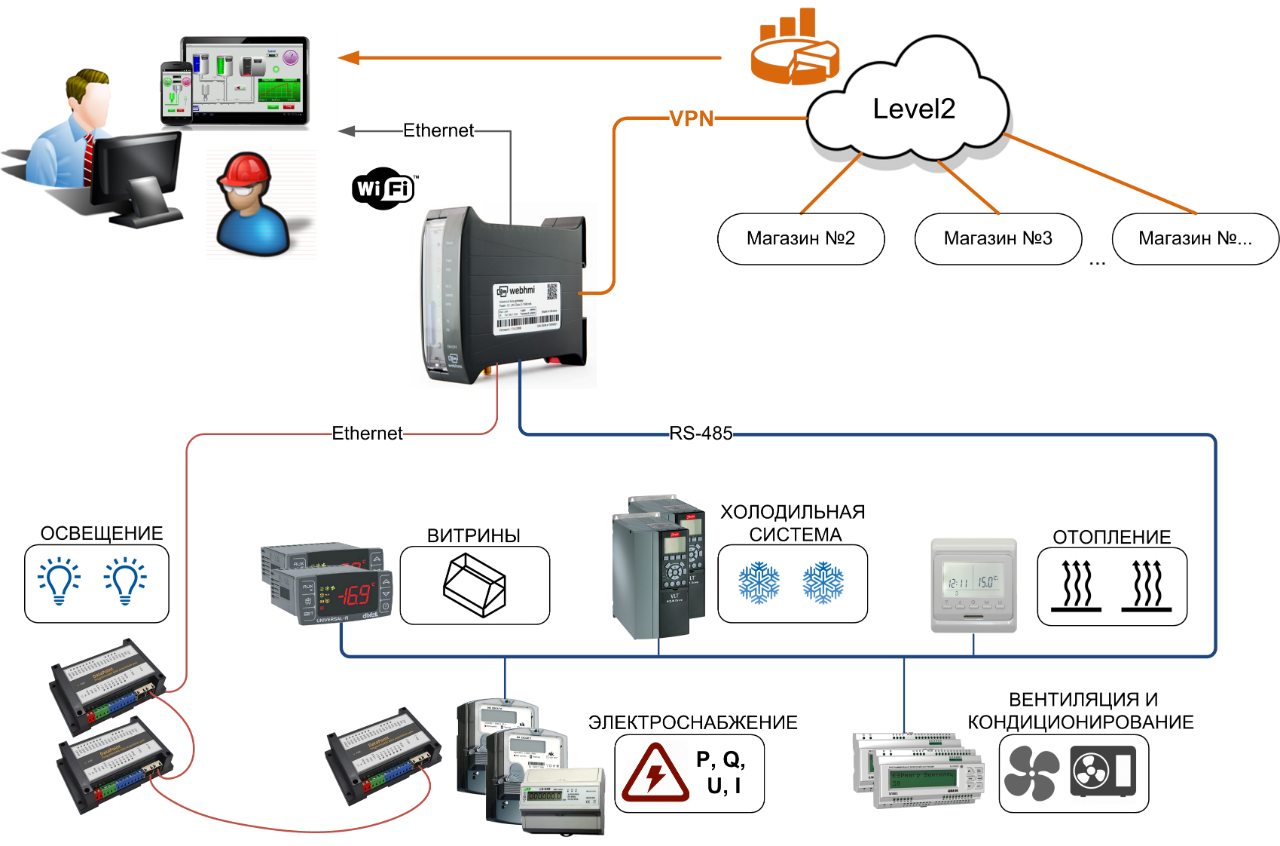
Regrigerators and freezing cameras
All current temperatures and alarm conditions in the cold rooms and showcases are displayed on the main screen, all images have a link where you can go and see detailed information for each device.
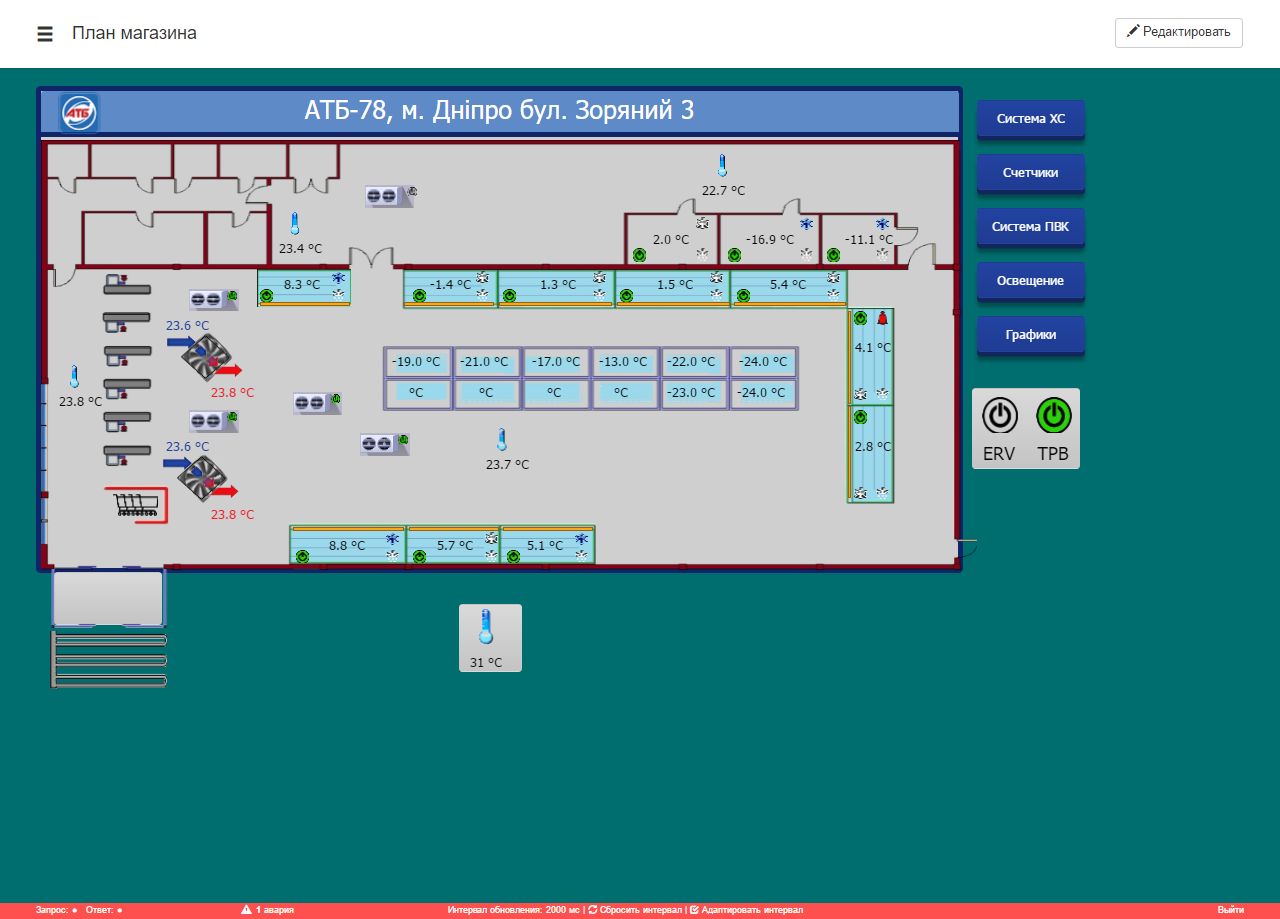
All temperatures are recorded on the graphs:
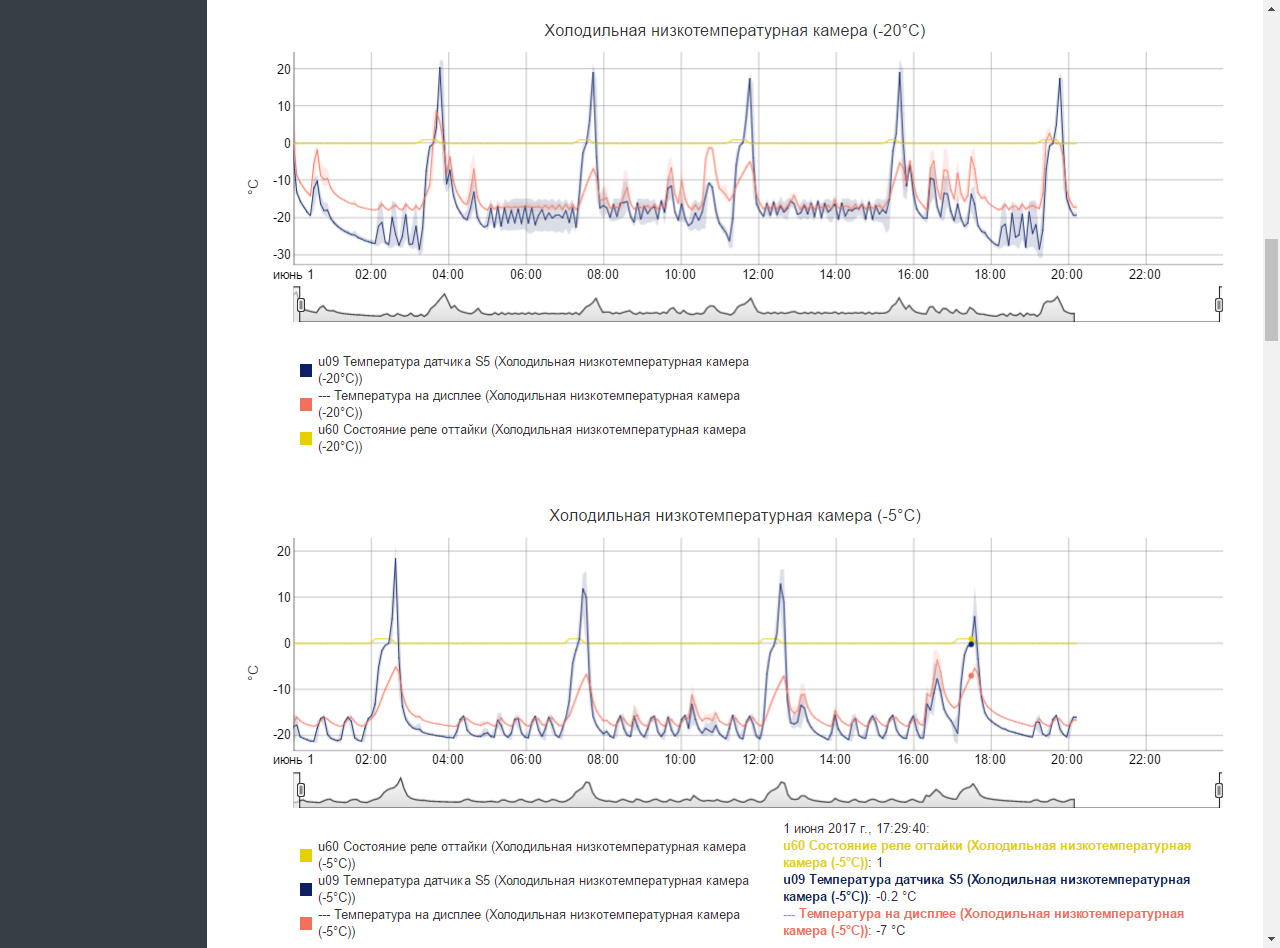
As it often happens, the developer had to work with the fact that there was – there were different shopwindows and refrigerators of different manufacturers in the store, some of which had different features of the Modbus protocol implementation – the function of auto-determining the speed of exchange and rebuilding its speed, not expecting other modules in the same network. When the whole store network was assembled and the project was configured, a surprise for installers was that the devices manage to ‘migrate’ to unpredictable speed of exchange and do not give a part of the data, which led to repeated readings and lengthening the poll cycle of the entire network. Immediately after the appearance of the problem, an elegant solution was found – all devices were sorted into a single continuous group in the project connection list and a ‘dummy connection’ was added before them – another connection of the same type with a few registers, the calls to which help to rebuild all ‘capricious’ devices at the speed they need.
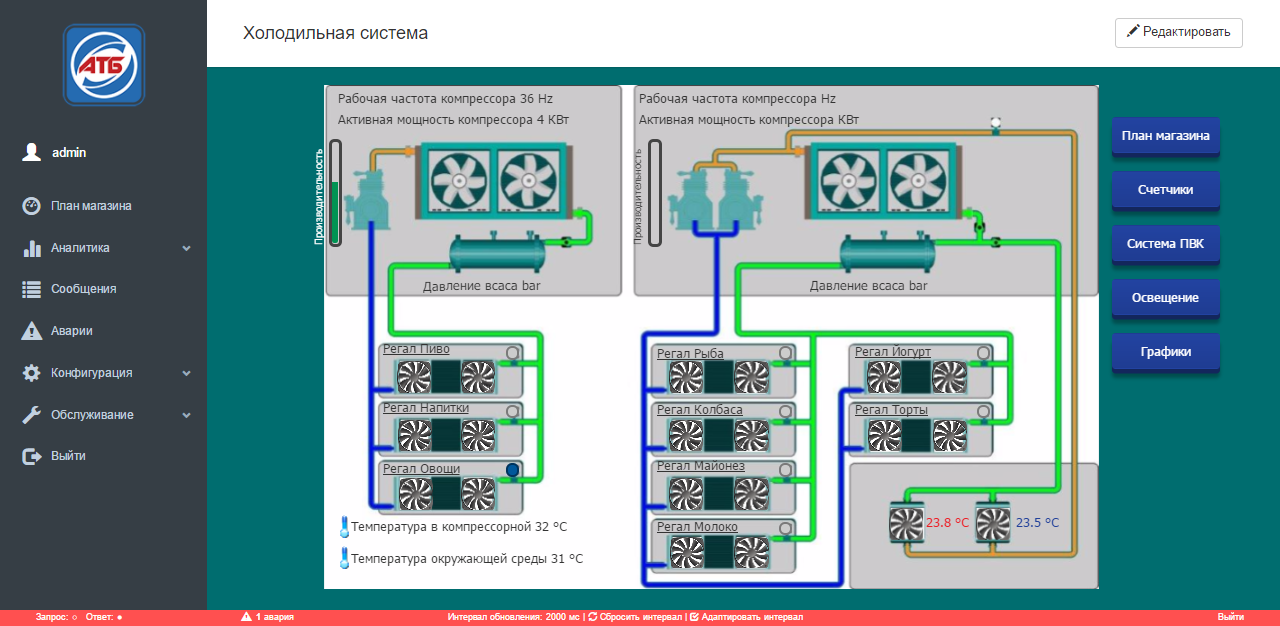
A reliable cold supply is a factor of high imortance(directly affecting the storage quality of perishable products in the chambers), therefore information on emergencies related to refrigerating chambers and the cold supply system is immediately sent to the appropriate employees in SMS- and Viber- messages, and all temperature charts are saved on both WebHMI and Level2.
Lighting
To control lighting, the remote I/O modules DAQ (TM WebHMI) were used. These modules have 8 digital inputs / 8 relay outputs, are powered from the 220V network, and are controlled via the Modbus TCP protocol. However, their key feature is the built-in dual port Ethernet switch , which allows you to easily increase the number of I/O points in the control cabinets by simply connecting the modules in daisy chain, without laying additional communications, as well as the possibility of extending the network segment (in a chain, up to 100 meters between modules) without the addition of additional points of consolidation (network switches) with a star topology.
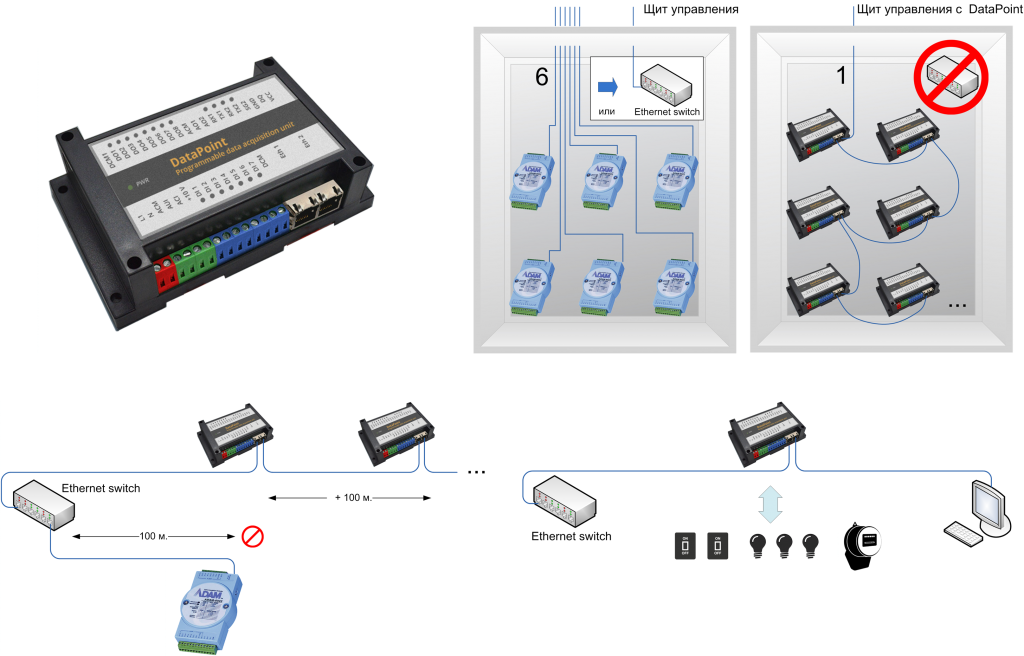
DAQ advanteges – simple cabling, lengthening network segment, using existing cables for signal input where it is needed.
The interface is represented by floor plans with the display of the status of the lighting groups and the possibility of direct remote control of them.

An easily configurable schedule for lighting control is implemented.
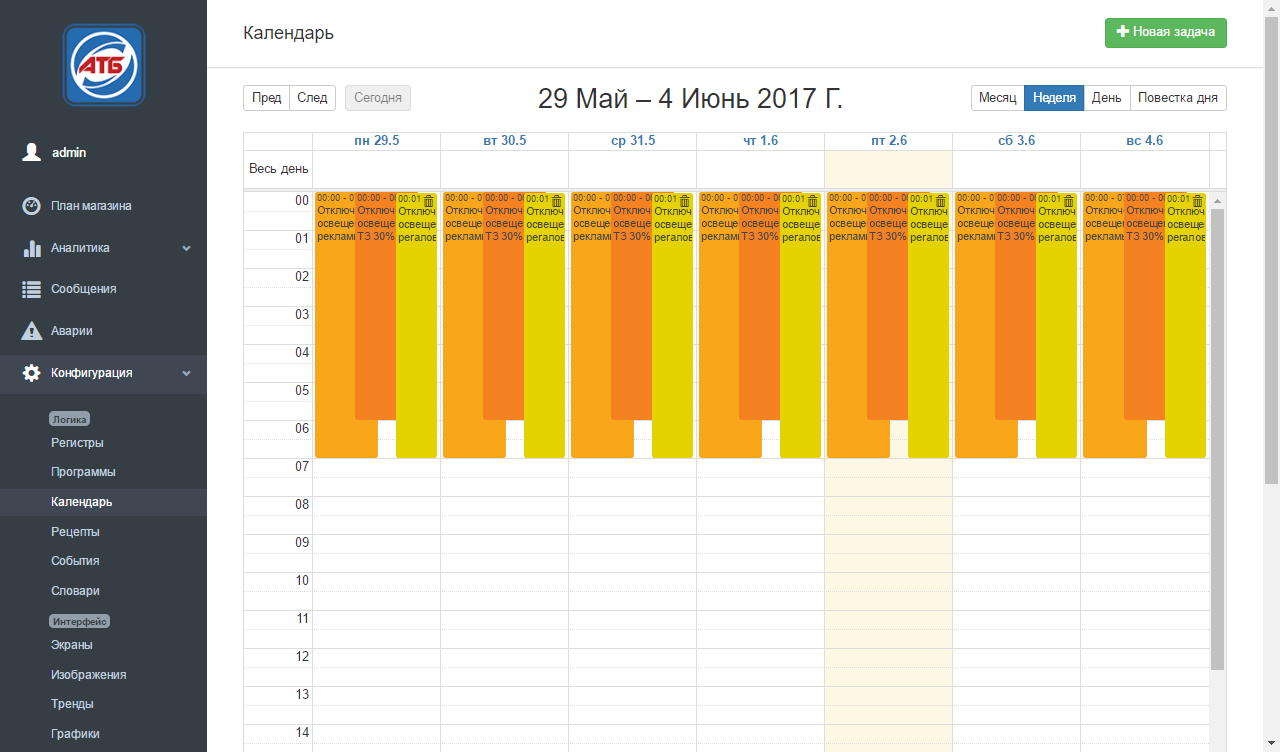
Ventilation and air conditioning
Air ventilation and conditioning system controllers had communication ports (Modbus, RS-485) and fully controlled the operation of the associated equipment. With features of cloining, importing and exporting the project objects, it was enough to make one object (connections to all necessary registers, visualization elements and scripts Lua ), and the rest were cloned the required number of times.
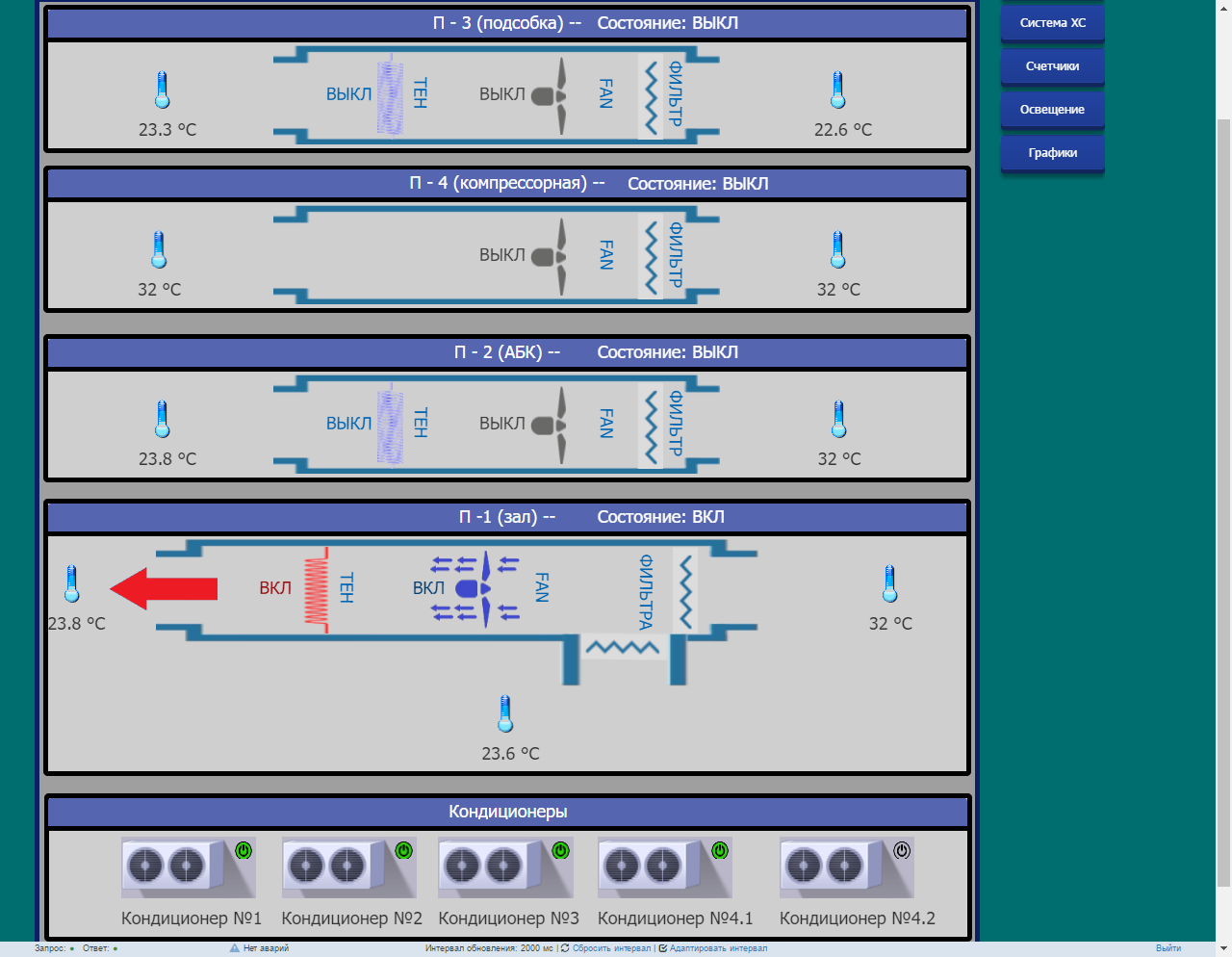
During the implementation of the system, it turned out that the information from the duct temperature sensors of the air-handling units is insufficient, requiring additional temperature sensors and also CO2 concentration sensors. Because laying additional communications cables over existing finishing and big distances turned out to be difficult, the wireless I / O modules
IO-Node (TM WebHMI) were used.
These modules are connected to the Wi-Fi network with the Modbus TCP protocol and provide the ability to connect up to 32 inexpensive temperature sensors via the 1-wire, CO2 sensor, and two digital inputs and outputs.
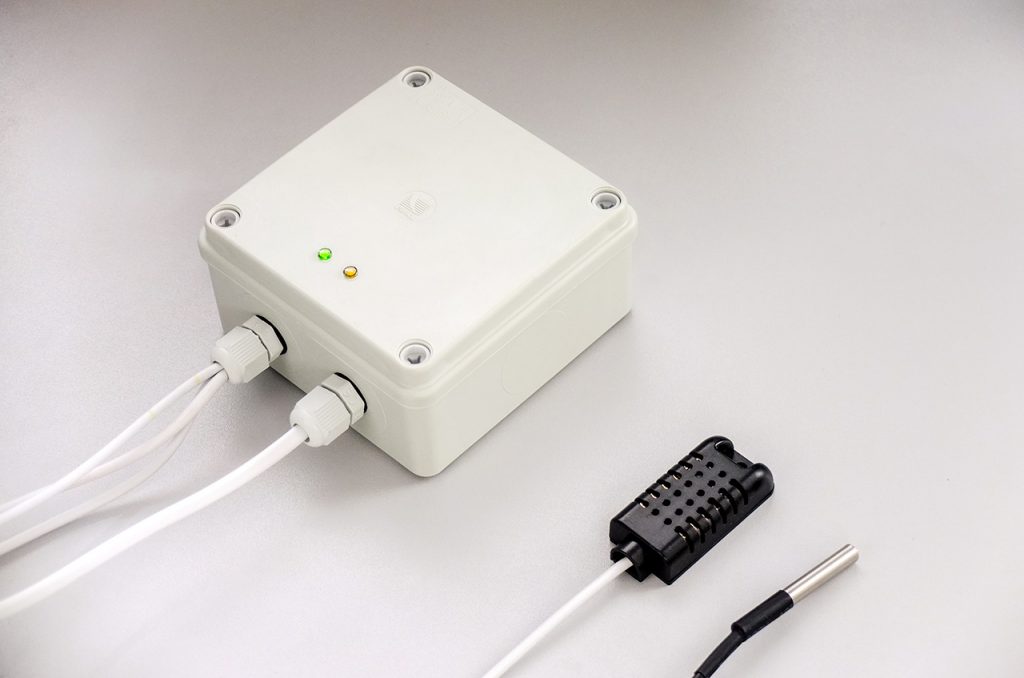
Electricity supply
Becuse of the large supermarket area and its considerable energy consumption, often exceeding the design parameters, the customer was extremely interested in issues of energy management – accounting for electricity consumption and improving energy efficiency. To do this, we collected data from the counters of all consumer groups, and also used the analysis tools for this data in Level2.
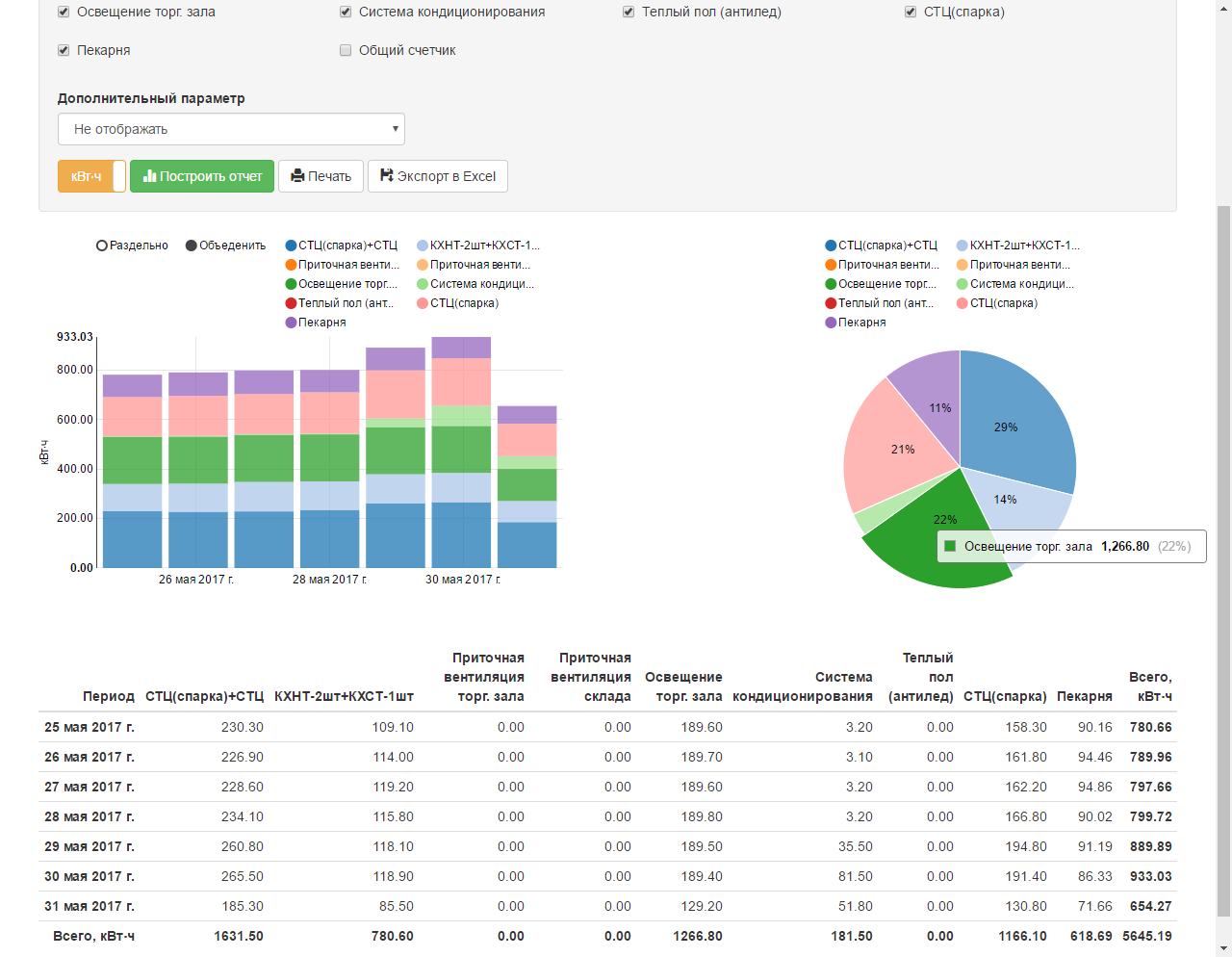
The popular NIK 2303 electric meters with their protocol supporting the DLMS/COSEM specification on the RS-485 bus were installed in the store, but some meters had only pulse outputs. WebHMI has 1 built-in RS-485 communication interface with the function multiprotocol , which allows counters with different interfaces to be included in one common bus. The remaining impulse signals were entered into the counting inputs DAQ (TM WebHMI), very handy here useful, for monitoring the status of switching devices in the control cabinet.
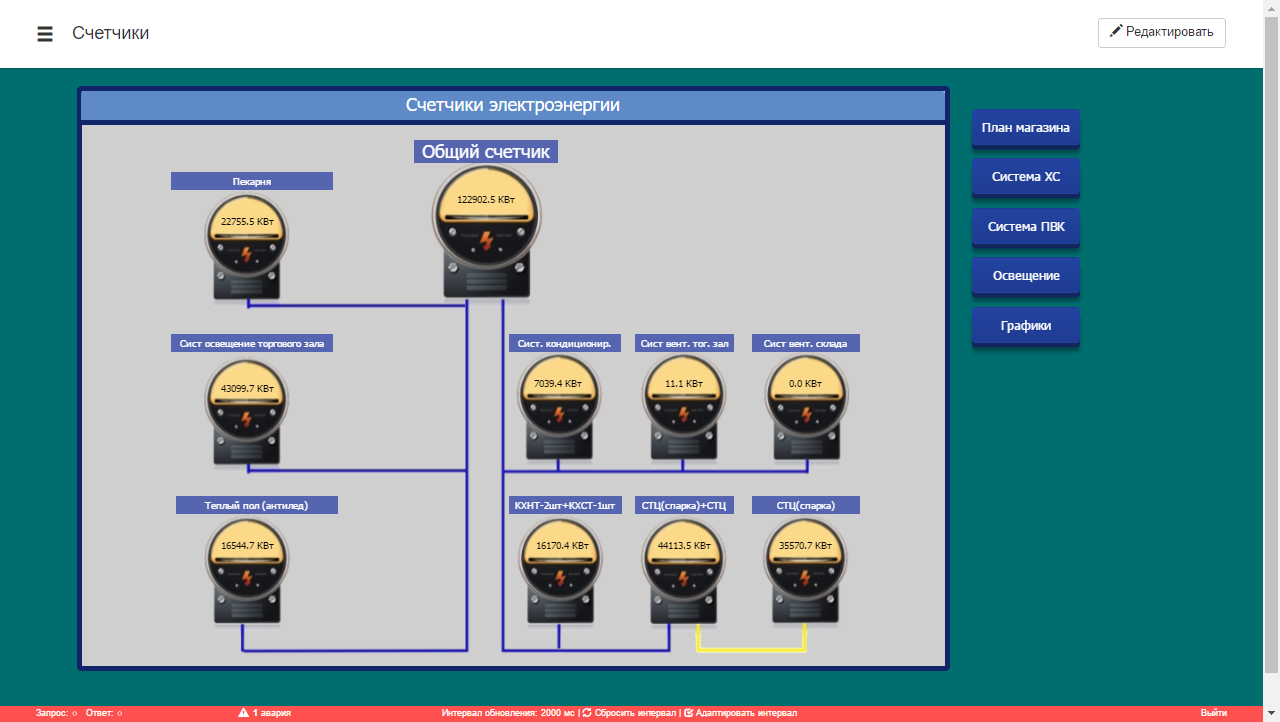
Maintenance
Despite the fact that the system is in non-stop operation, the customer constantly expands its functionality, expressing ever new wishes. Their implementation does not cause any difficulties, since WebHMI has a built-in development environment , allowing you to edit the current project directly in the browser, over the Internet, while the system is running, without compiling and reboots!
The function of the virtual COM port of WebHMI allows, too, to diagnose or parameterize drives or controllers remotely with their software tools, which also greatly facilitates the setup task, eliminating the need to go to the site.
Solution cost
The cost of the solution is always one of the key criteria along with the quality and volume of the functional, however in this project the cost and the term of implementation were several times less than it would be with the SCADA system. The peculiarity of the project was that all the initial costs for implementing the system are carried out by the contractor independently, and the final calculation is made by the customer only upon the achievement of the declared goals of the project, based on the results of 1 year of trial operation. The combination of the “master slave” architecture at the lower level and the “client-server” at the top level, as in the case of WebHMI and Level2, has the following advantages:
- The level of dispatching the whole store is made completely with one WebHMI module (operating in SCADA mode) with visualization, archiving, management and operator interface
- The upper level of dispatching is provided on the basis of SaaS (software as a service), ie. the customer immediately starts using data processing functions with zero start costs , paying a symbolic subscription fee (comparable to the cost of using the Internet)
- WebHMI modules store all historical data for a specified time interval and send copies of data to the Level2 server. In case communication loss with the upper level, the system continues to operate. And after the restoration of the connection it is simply synchronized with the server, providing reliability of data saving
- The system is easy to configure, the presence of automation functions for this process (import/export of tags, cloning of all system objects, templates for tags and visualization screens) allows the development of in a short time
- As a result of the above opportunities, the price of the solution turned out to be out of the competition and allowed the customer to win a “heavy” tender
About developer
The developer of the system- LLC “Astra”, and one of its main activities is the installing complex energy-efficient engineering solutions for trade networks and agro-industrial facilities.